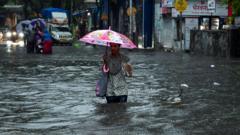The onset of monsoon rains in India typically brings relief, but for cities like Mumbai, it often results in chaos and disruption. In a recent bout of heavy rains, residents found themselves stranded amid flooding that overwhelmed even the most modern infrastructures, illustrating a crisis that extends far beyond mere weather patterns.
As floodwaters inundated roads and public transport faced cancellations and breakdowns, the Brihanmumbai Municipal Corporation (BMC) echoed familiar sentiments, attributing the flooding to clogged drains and construction debris. Recent images of an underground metro station submerged in muddy water further fueled public outrage and skepticism about the city’s preparedness.
This flooding issue isn’t exclusive to Mumbai. Cities from Delhi to Bengaluru are grappling with similar challenges each monsoon season. Roads buckle under pressure, sewage systems back up, and traffic grinds to a halt, leaving many to question urban planning vulnerabilities that contribute to these recurrent floods.
Experts highlight poor infrastructure and rapid urban growth as major culprits. "Urban sprawl has outpaced the development of essential drainage systems," says urban planner Dikshu Kukreja. "Outdated infrastructure, combined with neglect of natural water absorption areas, is creating disaster-prone scenarios." Indeed, many cities’ designs date back decades and lack the foresight to deal with today's climate challenges.
While monsoon rains are crucial for agriculture and sustenance in many rural regions, they also bring increased risks. This year's rains arrived with unexpected ferocity, leaving regions such as Delhi overwhelmed and resulting in significant property damage and loss of life. The Minto Bridge became emblematic of this urban flooding dilemma, highlighting how routine seasonal rains have taken a deadly turn.
Bengaluru’s situation reveals similar shortcomings, with historical lakes diminished by urban encroachment. Activist Ram Prasad points out how construction in these natural flood-plains has turned a city once adapted to seasonal rains into a high-risk flood zone.
The land’s natural defenses have been compromised, with actions such as mangrove deforestation amplifying the impacts of urban flooding. Kukreja asserts that the issues reflect a systemic breakdown, where planning efforts inadequately consider the consequences of climate variability, which has only intensified in recent years.
The flooding crisis also extends beyond large metropolitan areas, with smaller towns in northeastern India suffering devastating landslides and flood-related casualties. As the situation continues to escalate, the question remains—can effective preventative measures be implemented?
Experts suggest focusing on a coordinated long-term strategy involving technology such as real-time monitoring systems and predictive models to enhance disaster responsiveness. However, they caution against solely relying on tech-based solutions; community engagement and robust governance are equally essential.
To tackle the monsoon challenges facing India's urban environments, stakeholders must prioritize innovative planning that anticipates rather than reacts to natural calamities—ensuring that cities are more resilient amidst an unpredictable climate landscape.



















